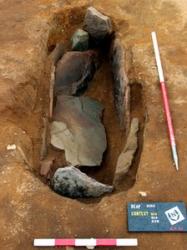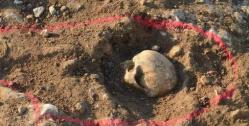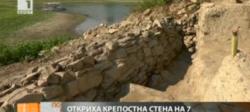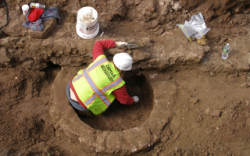INSTITUT SUPERIEUR D'ANTHROPOLOGIE
INSTITUTE OF ANTHROPOLOGY
ONLINE COURSES / COURS A DISTANCE
FALL TERM : OCTOBER 2013
REGISTER NOW
ROYAUME UNI –  Rhynie - The remains of what it is thought could be a member of early Pictish royalty have been discovered during an archaeological dig in Aberdeenshire. The discovery at Rhynie was made by teams from the universities of Aberdeen and Chester. The remains were found in a carefully made sandstone grave, which the experts believe suggests the person was of high status. It is the first time remains of a body have been uncovered at the site. Project leader Dr Gordon Noble, of the University of Aberdeen, said: "We found elements of the legs, pelvis and jaw bone which we recovered and are now analysing in the lab. "It's extremely rare to find any human remains from this era in the north east of Scotland as the soil in this part of the world is so acidic. "One of the graves had been carefully made from split sandstone slabs to create a cist and the stone lining and collapsed capstones helped to preserve skeletal material. "Unlike Anglo-Saxon areas to the south, the tradition in Scotland was largely for unfurnished burial so we didn't expect to find rich grave assemblages."
Rhynie - The remains of what it is thought could be a member of early Pictish royalty have been discovered during an archaeological dig in Aberdeenshire. The discovery at Rhynie was made by teams from the universities of Aberdeen and Chester. The remains were found in a carefully made sandstone grave, which the experts believe suggests the person was of high status. It is the first time remains of a body have been uncovered at the site. Project leader Dr Gordon Noble, of the University of Aberdeen, said: "We found elements of the legs, pelvis and jaw bone which we recovered and are now analysing in the lab. "It's extremely rare to find any human remains from this era in the north east of Scotland as the soil in this part of the world is so acidic. "One of the graves had been carefully made from split sandstone slabs to create a cist and the stone lining and collapsed capstones helped to preserve skeletal material. "Unlike Anglo-Saxon areas to the south, the tradition in Scotland was largely for unfurnished burial so we didn't expect to find rich grave assemblages."
http://www.bbc.co.uk/news/uk-scotland-north-east-orkney-shetland-24018459
FRANCE –  Airvault - Afin de terminer les travaux place des promenades, des sondages préventifs ont été entrepris. Toute la commune est protégée par les services de l'Etat pour la richesse de son patrimoine connu et inconnu. C'est pourquoi, tous les travaux sont précédés de mini-fouilles intitulées sondages préventifs. Le service du patrimoine de la commune était convaincu de l'existence d'un site funéraire important. Les services de l'INRAP* sont venus confirmer ces doutes. Mais ce site découvert à moins de 30 cm sous terre est beaucoup plus important que ne pouvaient le laisser penser les archives. Sur les 100m² fouillés, il a été découvert plus de 130 corps. David Martins, archéologue, explique que certaines sépultures ont été creusées dans le calcaire, d'autres ont des coffres. Des corps de morts nés, d'enfants, d'adolescents et d'adultes prouvent une occupation très importante. De plus la densité du nombre de squelettes laisse supposer que sous la mairie, la boulangerie ou le bar se trouve un monument d'importance pour les habitants de cette époque qui souhaitaient être tous inhumés ici. Malheureusement les premiers travaux des réseaux (eaux-égouts) de la rue Constant Balqué ont détruit déjà beaucoup de vestiges et réduisent la possibilité d'éclairer la connaissance des archéologues mais aussi de tous les habitants.
Airvault - Afin de terminer les travaux place des promenades, des sondages préventifs ont été entrepris. Toute la commune est protégée par les services de l'Etat pour la richesse de son patrimoine connu et inconnu. C'est pourquoi, tous les travaux sont précédés de mini-fouilles intitulées sondages préventifs. Le service du patrimoine de la commune était convaincu de l'existence d'un site funéraire important. Les services de l'INRAP* sont venus confirmer ces doutes. Mais ce site découvert à moins de 30 cm sous terre est beaucoup plus important que ne pouvaient le laisser penser les archives. Sur les 100m² fouillés, il a été découvert plus de 130 corps. David Martins, archéologue, explique que certaines sépultures ont été creusées dans le calcaire, d'autres ont des coffres. Des corps de morts nés, d'enfants, d'adolescents et d'adultes prouvent une occupation très importante. De plus la densité du nombre de squelettes laisse supposer que sous la mairie, la boulangerie ou le bar se trouve un monument d'importance pour les habitants de cette époque qui souhaitaient être tous inhumés ici. Malheureusement les premiers travaux des réseaux (eaux-égouts) de la rue Constant Balqué ont détruit déjà beaucoup de vestiges et réduisent la possibilité d'éclairer la connaissance des archéologues mais aussi de tous les habitants.
http://www.lanouvellerepublique.fr/Deux-Sevres/communes/Airvault/n/Contenus/Articles/2013/09/06/Decouvertes-exceptionnelles-1601483
BULGARIE –  Shoumen - The dry spell blanketing Bulgaria for the past two months has resulted in an unexpected archaeological discovery, with the remains of a 7000-year-old defensive wall emerging from the waters of the Ticha accumulation lake near the town of Shoumen in northeastern Bulgaria. The wall is more than five meters tall, made of rocks that are being held together by clay. The wall has an arrowslit and appears to be better built than other fortifications dating back to the same period in this part of Europe, historian Stefan Chohadjiev from Veliko Turnovo University told Bulgarian National Television. On the southern approach of the hill, the fortification is at its strongest, with three parallel lines of defence built to repel attackers. The inhabitants of the stronghold appear to have been a frequent target of attacks, this being the most likely reason why its defences have been built up, instead of featuring only the more traditional moat, according to Chohadjiev. Remains of a village that had been inhabited for several centuries can be found inside the wall – most likely, it was the stronghold of the local warlords who ruled the surrounding vale, Chohadjiev said. The items found on the site, including luxury items (marble and jade jewellery) and military equipment, appear to confirm such a hypothesis, he said. The wall had been rebuilt at least once, after parts of it collapsed inward, likely as a result of an earthquake, destroying several nearby homes.
Shoumen - The dry spell blanketing Bulgaria for the past two months has resulted in an unexpected archaeological discovery, with the remains of a 7000-year-old defensive wall emerging from the waters of the Ticha accumulation lake near the town of Shoumen in northeastern Bulgaria. The wall is more than five meters tall, made of rocks that are being held together by clay. The wall has an arrowslit and appears to be better built than other fortifications dating back to the same period in this part of Europe, historian Stefan Chohadjiev from Veliko Turnovo University told Bulgarian National Television. On the southern approach of the hill, the fortification is at its strongest, with three parallel lines of defence built to repel attackers. The inhabitants of the stronghold appear to have been a frequent target of attacks, this being the most likely reason why its defences have been built up, instead of featuring only the more traditional moat, according to Chohadjiev. Remains of a village that had been inhabited for several centuries can be found inside the wall – most likely, it was the stronghold of the local warlords who ruled the surrounding vale, Chohadjiev said. The items found on the site, including luxury items (marble and jade jewellery) and military equipment, appear to confirm such a hypothesis, he said. The wall had been rebuilt at least once, after parts of it collapsed inward, likely as a result of an earthquake, destroying several nearby homes.
http://sofiaglobe.com/2013/09/09/archaeology-7000-year-old-defensive-wall-emerges-near-bulgarias-shoumen/
USA –  Providence - Results have been impressive. At a recent South Street Seaport infrastructure excavation, archaeologists uncovered a large number of British buttons dating back to the days of the Revolutionary War as well as wooden water mains dating to the early 19th century. Other artifacts discovered during the Fulton Street redevelopment include table settings, residential wells and the ruins of an old print shop. Brooklyn-based Chrysalis, a certified specialist in archaeological and cultural resource services, welcomes the opportunity to tackle new assignments. Presently, the company is working with Schiavone Construction on the renovation of the East River's High Bridge span. It is also lending its resources to the preservation of the historic John Bowne House in Queens, N.Y., where professionals have already uncovered an ancient laundry room cistern containing artifacts left by nine generations of the Bowne family over more than 250 years.
Providence - Results have been impressive. At a recent South Street Seaport infrastructure excavation, archaeologists uncovered a large number of British buttons dating back to the days of the Revolutionary War as well as wooden water mains dating to the early 19th century. Other artifacts discovered during the Fulton Street redevelopment include table settings, residential wells and the ruins of an old print shop. Brooklyn-based Chrysalis, a certified specialist in archaeological and cultural resource services, welcomes the opportunity to tackle new assignments. Presently, the company is working with Schiavone Construction on the renovation of the East River's High Bridge span. It is also lending its resources to the preservation of the historic John Bowne House in Queens, N.Y., where professionals have already uncovered an ancient laundry room cistern containing artifacts left by nine generations of the Bowne family over more than 250 years.
http://www.digitaljournal.com/pr/1455865
INDE –  Kedarnath - The Archaeological Survey of India will soon be sending a five-member team of scientists, archaeologists and engineers to Kedarnath to commence conservation work at the ancient Kedarnath Temple, which was damaged during the recent flash floods in Uttarakhand. Preliminary reports indicate that the temple’s overall structure is fairly conserved. But portions of the temple on its northern, western and eastern sides have indicated a moderate impact from the floods and boulder movement. The temple structure was saved primarily due to a large boulder onits northern side, which deflected water and debris.
Kedarnath - The Archaeological Survey of India will soon be sending a five-member team of scientists, archaeologists and engineers to Kedarnath to commence conservation work at the ancient Kedarnath Temple, which was damaged during the recent flash floods in Uttarakhand. Preliminary reports indicate that the temple’s overall structure is fairly conserved. But portions of the temple on its northern, western and eastern sides have indicated a moderate impact from the floods and boulder movement. The temple structure was saved primarily due to a large boulder onits northern side, which deflected water and debris.
http://www.thehindu.com/news/national/other-states/asi-draws-up-plan-for-kedarnath-restoration/article5108133.ece?homepage=true
FRANCE –  Talmont Saint Hilaire - Une nouvelle campagne de fouille vient de débuter au château de Talmont Saint-Hilaire et devrait se poursuivre jusqu’au 13 septembre. Depuis 2009, des fouilles archéologiques soutenues par la mairie de Talmont-Saint-Hilaire et la Direction des Affaires culturelles Pays de la Loire sont menées au château de Talmont. Depuis plusieurs jours, une équipe d’une dizaine de bénévoles et d’étudiants en histoire du Moyen-äge sont à l’œuvre sous la conduite de Teddy Bethus et Nicolas Prouteau deux archéologues habitués des lieux. « Le château de Talmont est un site important de l’époque médiévale un exemple de l’architecture castrale de pointe de la fin du XIIe et du début du XIIIe siècle » explique Nicolas Prouteau.
Talmont Saint Hilaire - Une nouvelle campagne de fouille vient de débuter au château de Talmont Saint-Hilaire et devrait se poursuivre jusqu’au 13 septembre. Depuis 2009, des fouilles archéologiques soutenues par la mairie de Talmont-Saint-Hilaire et la Direction des Affaires culturelles Pays de la Loire sont menées au château de Talmont. Depuis plusieurs jours, une équipe d’une dizaine de bénévoles et d’étudiants en histoire du Moyen-äge sont à l’œuvre sous la conduite de Teddy Bethus et Nicolas Prouteau deux archéologues habitués des lieux. « Le château de Talmont est un site important de l’époque médiévale un exemple de l’architecture castrale de pointe de la fin du XIIe et du début du XIIIe siècle » explique Nicolas Prouteau.
http://www.ouest-france.fr/actu/actuLocale_-Talmont-Saint-Hilaire.-Nouvelle-campagne-de-fouille-au-chateau_40771-2225738-pere-redac--85191-abd_filDMA.Htm
FRANCE –  Saintes - En préalable à la construction de trois maisons individuelles situées entre la rue Daniel-Massiou et la rue des Thermes Romains à Saintes, une fouille préventive a été prescrite par l’État (Drac Poitou-Charentes), sur une surface de 3 000 m2. Les recherches menées par les archéologues de l’Inrap devraient durer jusqu’à la fin du moins d’octobre 2013. Les objectifs de la fouille consistent à étudier l’évolution de ce quartier du nord de Saintes, abritant une importante activité artisanale (métallurgie, céramique, verrerie, travail de l'os, etc.) dès l'époque augustéenne (fin du Ier siècle avant et début du Ier siècle de notre ère), avant d’être urbanisé dans le courant du Ier siècle, puis progressivement abandonné avec la mise en place de nécropoles à la fin du IIe siècle jusqu’au Ve siècle.
Saintes - En préalable à la construction de trois maisons individuelles situées entre la rue Daniel-Massiou et la rue des Thermes Romains à Saintes, une fouille préventive a été prescrite par l’État (Drac Poitou-Charentes), sur une surface de 3 000 m2. Les recherches menées par les archéologues de l’Inrap devraient durer jusqu’à la fin du moins d’octobre 2013. Les objectifs de la fouille consistent à étudier l’évolution de ce quartier du nord de Saintes, abritant une importante activité artisanale (métallurgie, céramique, verrerie, travail de l'os, etc.) dès l'époque augustéenne (fin du Ier siècle avant et début du Ier siècle de notre ère), avant d’être urbanisé dans le courant du Ier siècle, puis progressivement abandonné avec la mise en place de nécropoles à la fin du IIe siècle jusqu’au Ve siècle.
http://www.inrap.fr/archeologie-preventive/Actualites/Communiques-de-presse/p-16314-Journee-portes-ouvertes-dimanche-15-septembre-2013-Le-quartier-antique-de-Saint-Saloine-a-Saintes-Charente-Maritime-.htm